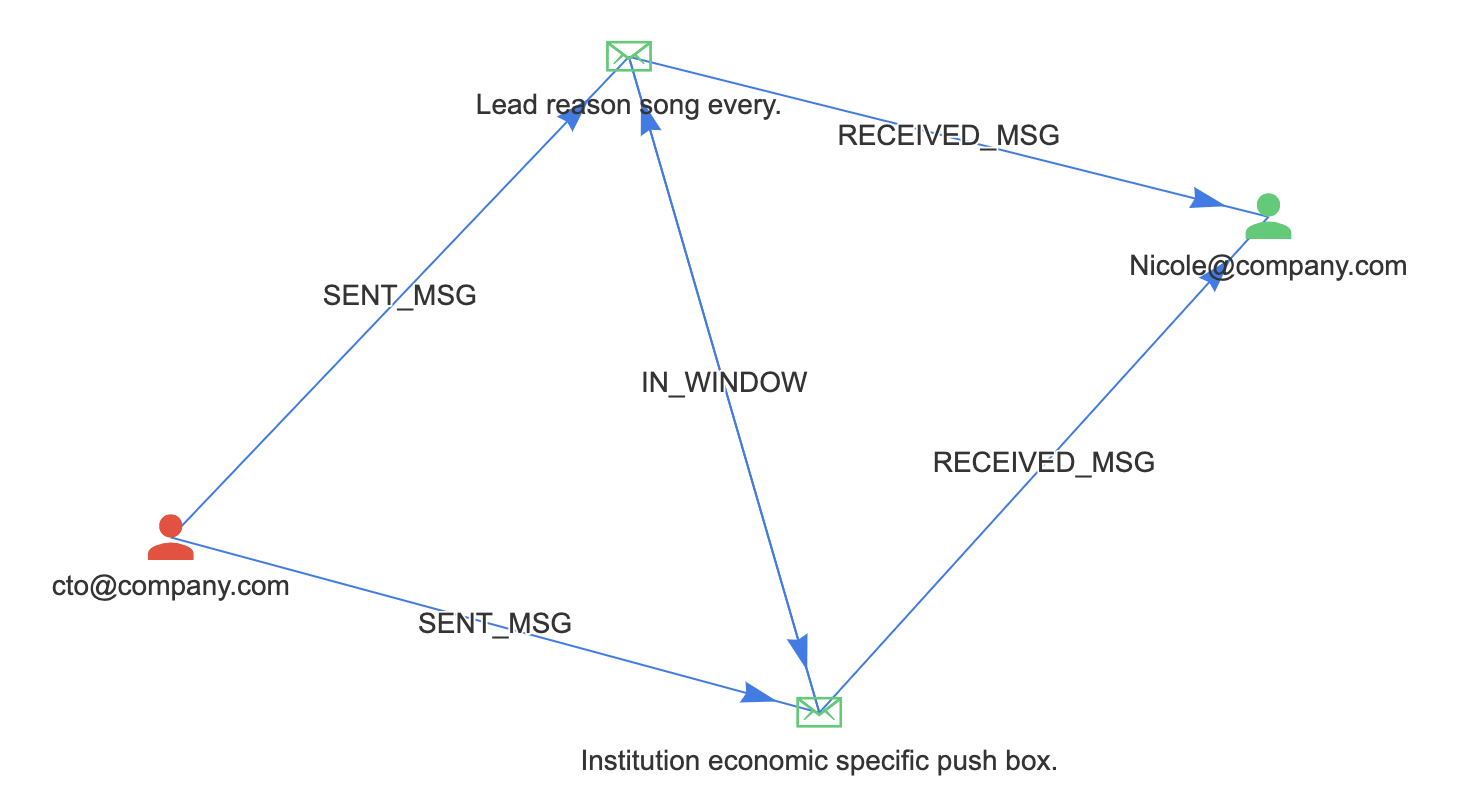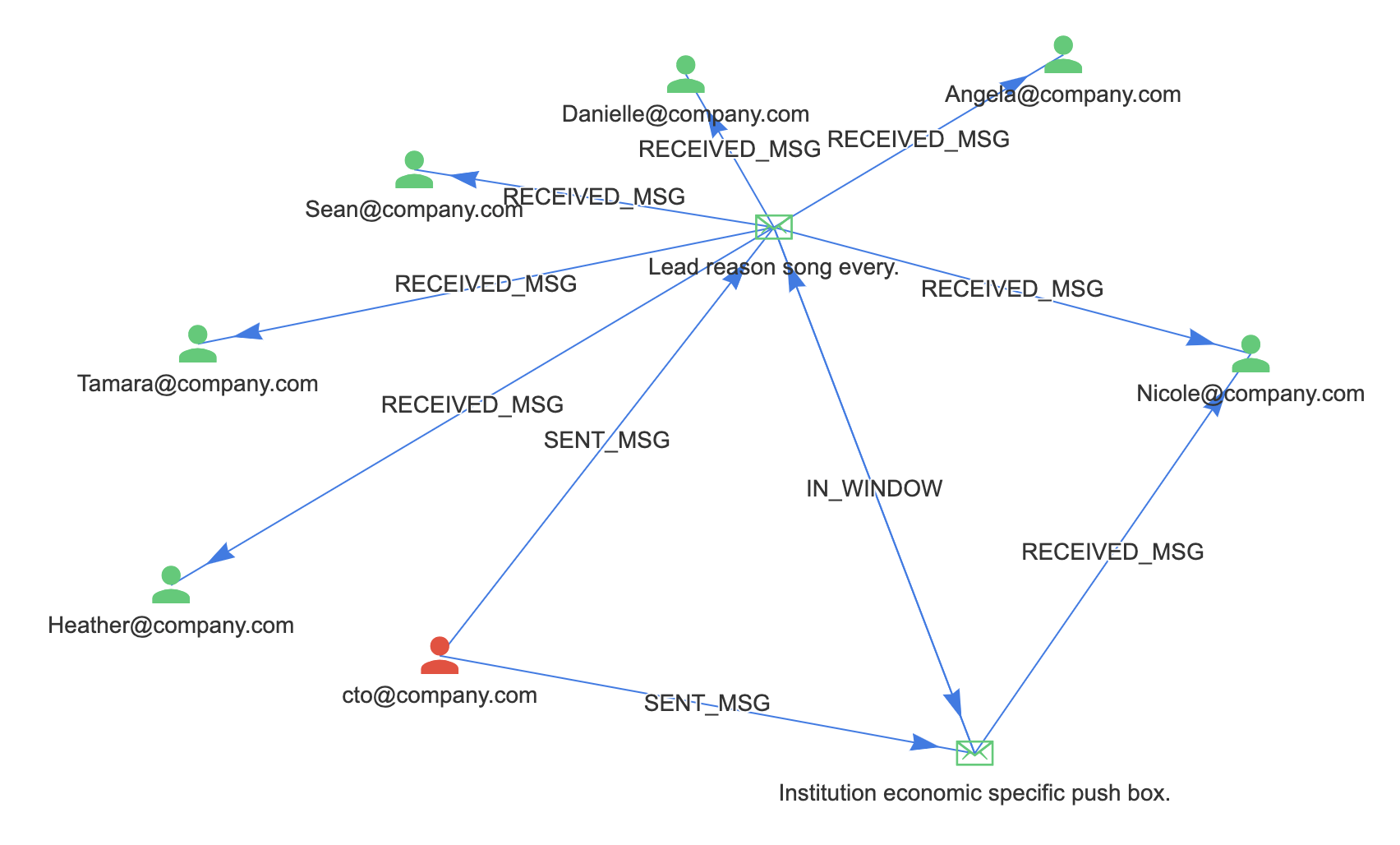Temporal Locality
Full Recipe¶
Shared by: Michael Aglietti
This recipe looks for emails sent or received by cto@company.com within a sliding window as a means of highlighting a technique for matching on temporal locality of nodes in standing queries.
Temporal Locality Recipe
1 2 3 4 5 6 7 8 9 10 11 12 13 14 15 16 17 18 19 20 21 22 23 24 25 26 27 28 29 30 31 32 33 34 35 36 37 38 39 40 41 42 43 44 45 46 47 48 49 50 51 52 53 54 55 56 57 58 59 60 61 62 63 64 65 66 67 68 69 70 71 72 73 74 75 76 77 78 79 80 81 82 83 84 85 86 87 88 89 90 91 92 93 94 95 96 97 98 99 100 101 102 103 104 105 106 107 108 109 110 111 112 113 114 115 116 117 118 119 120 121 122 123 124 125 126 127 128 129 130 131 132 133 134 135 136 137 138 139 140 141 142 143 144 145 | |
Scenario¶
This scenario processes records containing metadata for almost 295,000 emails are ingested for the purpose of identifying emails to/from a specific email address within a sliding 2-minute window.
{
"from": <sender>,
"to": [<recipients>],
"subject": <email subject line>,
"time": <epoch time timestamp>,
"sequence": <sequence number>
}
Sample Data¶
Download the sample data to the same directory as the recipe and where Quine will be run.
How it Works¶
The recipe reads data from a sample data file using an ingest stream and parses each line into sender, receiver and message nodes to manifest a graph in Quine.
INGEST-1 processes the email.json file:
- type: FileIngest
path: email.json
format:
type: CypherJson
query: |-
MATCH (sender), (message)
WHERE id(sender) = idFrom('email', $that.from)
AND id(message) = idFrom('message', $that)
SET sender.email = $that.from,
sender: Email,
message.from = $that.from,
message.to = $that.to,
message.subject = $that.subject,
message.time = datetime({epochMillis: $that.time}),
message: Message
CREATE (sender)-[:SENT_MSG]->(message)
WITH $that AS t, message
UNWIND t.to AS rcv
MATCH (receiver)
WHERE id(receiver) = idFrom('email', rcv)
SET receiver.email = rcv,
receiver: Email
CREATE (message)-[:RECEIVED_MSG]->(receiver)
{
"type": "FileIngest",
"path": "email.json",
"format": {
"type": "CypherJson",
"query": "MATCH (sender), (message) \\nWHERE id(sender) = idFrom('email', $that.from)\\n AND id(message) = idFrom('message', $that) \\n\\nSET sender.email = $that.from,\\n sender: Email,\\n message.from = $that.from,\\n message.to = $that.to,\\n message.subject = $that.subject,\\n message.time = datetime({ epochMillis: $that.time}),\\n message: Message\\n\\nCREATE (sender)-\[:SENT\_MSG\]->(message)\\n\\nWITH $that as t, message\\nUNWIND t.to AS rcv\\nMATCH (receiver)\\nWHERE id(receiver) = idFrom('email', rcv)\\n\\nSET receiver.email = rcv,\\n receiver: Email\\n\\nCREATE (message)-\[:RECEIVED\_MSG\]->(receiver)"
}
}
A standing query is configured to detect when emails that are sent or received by cto@company.com are within a two minute sliding window of one another.
The pattern query matches each individual (sender)-[:SENT_MSG]->(message)-[:RECEIVED_MSG]->(receiver) pattern.
- pattern:
type: Cypher
mode: MultipleValues
query: |-
MATCH (n)-[:SENT_MSG]->(m)-[:RECEIVED_MSG]->(r)
WHERE n.email="cto@company.com" OR r.email="cto@company.com"
RETURN id(n) as ctoId, id(m) as ctoMsgId, m.time as mTime, id(r) as recId
Once the pattern query matches the (sender)-[:SENT_MSG]->(message)-[:RECEIVED_MSG]->(receiver) pattern, an event is sent to an output query to calculate the temporal locality using the Cypher duration.between() function to establish a sliding window of interest.
duration("PT6M") > duration.between(m.time,thisMsg.time) > duration("PT4M")
The expression utilizes Cypher-defined temporal data types, based on ISO 8601 format, PT6M and PT4M to represent 6 minutes < duration >4 minutes for the window. We are able to use this because we converted the ingested epoch time formatted timestamp to datetime format in the ingest query.
message.time = datetime({epochMillis: $that.time})
Otherwise, we would have cast the data within the standing query:
AND duration("PT6M") > duration.between(datetime({epochMillis: m.time}),datetime({epochMillis: thisMsg.time})) > duration("PT4M")
Using the former pattern allows us to to express the standing query in a clean, simple manner.
outputs:
withinFourToSixMinuteWindow:
type: CypherQuery
query: |-
MATCH (n)-[:SENT_MSG]->(m)-[:RECEIVED_MSG]->(r), (thisMsg)
WHERE id(n) = $that.data.ctoId
AND id(r) = $that.data.recId
AND id(thisMsg) = $that.data.ctoMsgId
AND id(m) <> id(thisMsg)
AND duration("PT6M") > duration.between(m.time,thisMsg.time) > duration("PT4M")
CREATE (m)-[:IN_WINDOW]->(thisMsg)
CREATE (m)<-[:IN_WINDOW]-(thisMsg)
WITH n, m, r, "http://localhost:8080/#MATCH" + text.urlencode(' (n)-[:SENT_MSG]->(m)-[:RECEIVED_MSG]->(r) WHERE strId(n)="' + strId(n) + '"AND strId(r)="' + strId(r) + '" AND strId(m)="' + strId(m) + '" RETURN n, r, m') as URL
RETURN URL
andThen:
type: PrintToStandardOut
When a complete pattern match is detected the recipe outputs a link to the console for an analyst to use when reviewing the event further inside Quine's Exploration UI.
2023-02-23 12:04:24,981 Standing query `withinFourToSixMinuteWindow` match: {"meta":{"isPositiveMatch":true,"resultId":"628d6523-4d25-4cb4-aed2-9890ecf0cb9c"},"data":{"URL":"http://localhost:8080/#MATCH%20%28n%29-%5B%3ASENT_MSG%5D-%3E%28m%29-%5B%3ARECEIVED_MSG%5D-%3E%28r%29%20WHERE%20strId%28n%29%3D%22a69876bc-8876-37e9-b776-471507a080b9%22AND%20strId%28r%29%3D%2299eeafc4-3178-3aca-8c7c-f84d0781f3a1%22%20AND%20%20strId%28m%29%3D%229e66e020-45ad-3971-92ec-60be8fa844e7%22%20RETURN%20n%2C%20r%2C%20m"}}
Running the Recipe¶
❯ java -jar quine-1.9.3.jar -r duration.yaml
Graph is ready
Running Recipe: Temporal Locality Example
Using 3 node appearances
Using 5 quick queries
Running Standing Query STANDING-1
Running Ingest Stream INGEST-1
Quine web server available at http://localhost:8080
Almost immediately positive matches will begin to stream to your console window.
2023-02-23 14:12:05,165 Standing query `withinFourToSixMinuteWindow` match: {"meta":{"isPositiveMatch":true,"resultId":"52c981a4-394f-48c3-8419-671fe5f0c1d5"},"data":{"URL":"http://localhost:8080/#MATCH%20%28n%29-%5B%3ASENT_MSG%5D-%3E%28m%29-%5B%3ARECEIVED_MSG%5D-%3E%28r%29%20WHERE%20strId%28n%29%3D%22a69876bc-8876-37e9-b776-471507a080b9%22AND%20strId%28r%29%3D%22c57f8f3b-b567-3b7e-b2a2-c516f030ce2f%22%20AND%20%20strId%28m%29%3D%221c0bc726-4a19-363d-a623-f5df12142a72%22%20RETURN%20n%2C%20r%2C%20m"}}
Copy and paste the URL into your browser (or ++"cmd+click"++ on a Mac) to open the Exploration UI and display an email event.
Right click on one of the email messages and select [Node] Messages in Window to find other messages that occured within the time window.
Continue to right click and run queries to discover other messages that we sent but not did not occur within the time window.
Summary¶
This simple recipe shows how the duration.between() temporal function is able to implement a sliding window for matching events that happen close to gether in time.
Tip
Quick Queries are available by right clicking on a node.
| Quick Query | Node Type | Description |
|---|---|---|
| Adjacent Nodes | All | Display the nodes that are adjacent to this node. |
| Refresh | All | Refresh the content stored in a node |
| Local Properties | All | Display the properties stored by the node |
| Messages in Window | Messages | Display all message nodes within the sliding window |
| Table of Messages in Window | Messages | Return a list of messages and time deltas |


